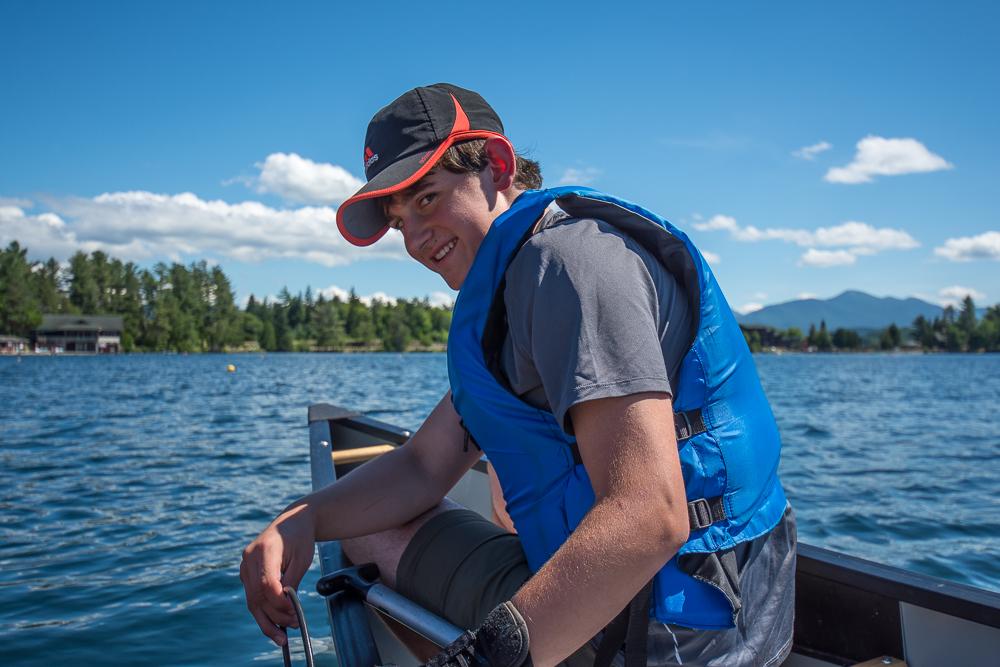Discovering the Ausable: An Aquatic Stewardship Program is a partnership program between Ausable Freshwater Center and Adirondack Mountain Club that teaches teens outdoor recreational skills, provides them hands-on experiences with scientific methods, and inspires an ethic of environmental stewardship. Since 2015, this high-impact program exposes youth to the aquatic sciences and watershed stewardship in an immersive learning environment. Explore the photo essay below to learn more about this successful AsRA program.
Day 1: Paddling and Topo Map Skills

The first day of the program the participants learn about paddling skills on Heart Lake. ADK's Education staff teach everyone how to do forward, backward, sweep, and draw strokes. Paddling skills are put to the test during several rounds of Dead Fish Polo, where each canoe tries to maneuver two sponges in the lake and fling them into another boat. Next, we go over what to do if a boat flips in the middle of the lake. Safety is the number one priority and everyone gets a chance to paddle their canoe. After a demo of how to do a t-rescue on shore, everyone paddles to the middle of the lake and take turns flipping and recovering their canoe. After a full day on the water, the group usually climbs up Mount Jo to learn how to read a topographic map and draw a watershed boundary.
Day 2: Comparative Study of Heart Lake and Mirror Lake

Day two is all about science. The group starts off the morning on the shores of Heart Lake brainstorming threats to our local waterbodies and then learning about stratification, turnover, and the aquatic food web. Once everyone undertstands the threats to our water, we learn about the different tests and data we can collect to assess those threats. We take vertical profiles of temperature, dissolved oxygen, specific conductance, and pH, as well as a surface and deep water sample that we analyze for nitrate, phosphorus, alkalinity, and chloride. The students also learn about Secchi depth and how to take a reading using a Secchi disk. After collecting data on Heart Lake, we load up our boats and equipment and head off to Mirror Lake. Before heading out on Mirror Lake we usually visit with one of the Adirondack Watershed Institute's Watershed Stewards to learn about aquatic invasive species. After a full day on the water collecting data, we travel back to the Adirondack Mountain Club's Wilderness Campground to cook dinner. Under fading light, we graph our data collected for the day and discussed the differences between the two lakes and how we can address the threats facing Mirror Lake.
Day 3: Benthic Macroinvertebrates and Fish of the Ausable

After a full day of learning about water chemistry, we transition to learning about the organisms that live in our rivers and streams and how we can use them to assess the health of aquatic ecosystems. As a group, we sample and identify minnows in Heart Lake and benthic macroinvertebrates found in the East Branch Ausable River in Keene. Using this information, we run our data through a number of indices to assess the quality of the water. New this year, we added snorkeling to the agenda to help the teens get an up-close look at the vibrant aquatic life that calls our lakes home.
Day 4: Being Good Stewards

It's one thing to learn about the threats to the health of our waters, but another to figure out how to do something about it. This day is all about making a positive impact on the Ausable River. Unfortunately, the lower portion of the Ausable River, as it passes through the Ausable Marsh, has a lot of trash in and along the banks of the river. As a group, we paddle a loop through the marsh collecting trash along the way. We usually gather up several hundred pounds of trash, including several of the many tires found in this stretch of the river.
Day 5: Bringing It Home
To wrap up the week, the teens held a mock town hall-style meeting that sparked great conversations about the importance of stewardship and the future of our beloved rivers and lakes. By the end of the week, everyone in the group can perfectly execute a draw stroke with an in-water return to raft their boats together, rescue a flipped boat, read a topographic map and draw a watershed boundary. Everyone can define a variety of limnological terms, collect and analyze water samples, identify invasive species, and are prepared to take action to become better stewards of their local watersheds. Hands-on education makes a big impact in individual lives and in communities, is rewarding for teachers and students alike, and helps AFC and ADK protect our watershed and those beyond.
This program is conducted in partnership with Adirondack Mountain Club and is funded from a Lake Champlain Basin Program and NEIWPCC.
Sign-up for our e-newsletter to get weekly updates on the latest stories from the Ausable Freshwater Center.



















